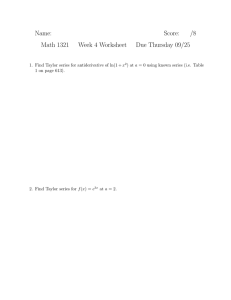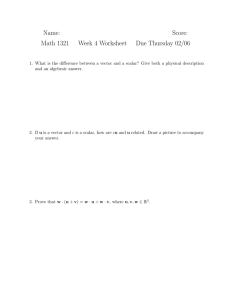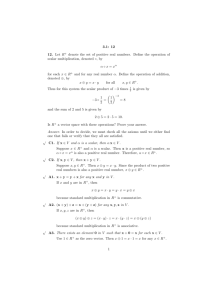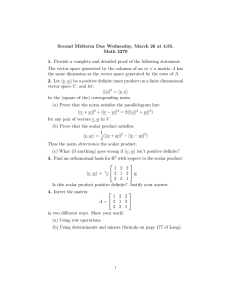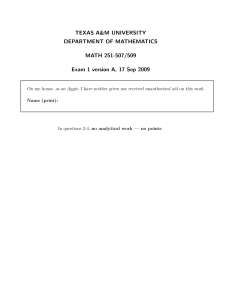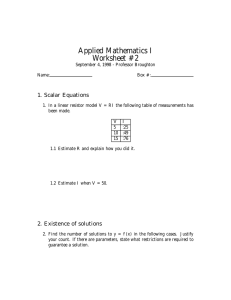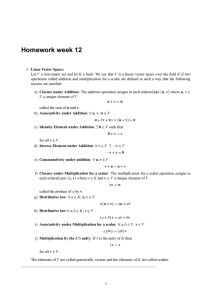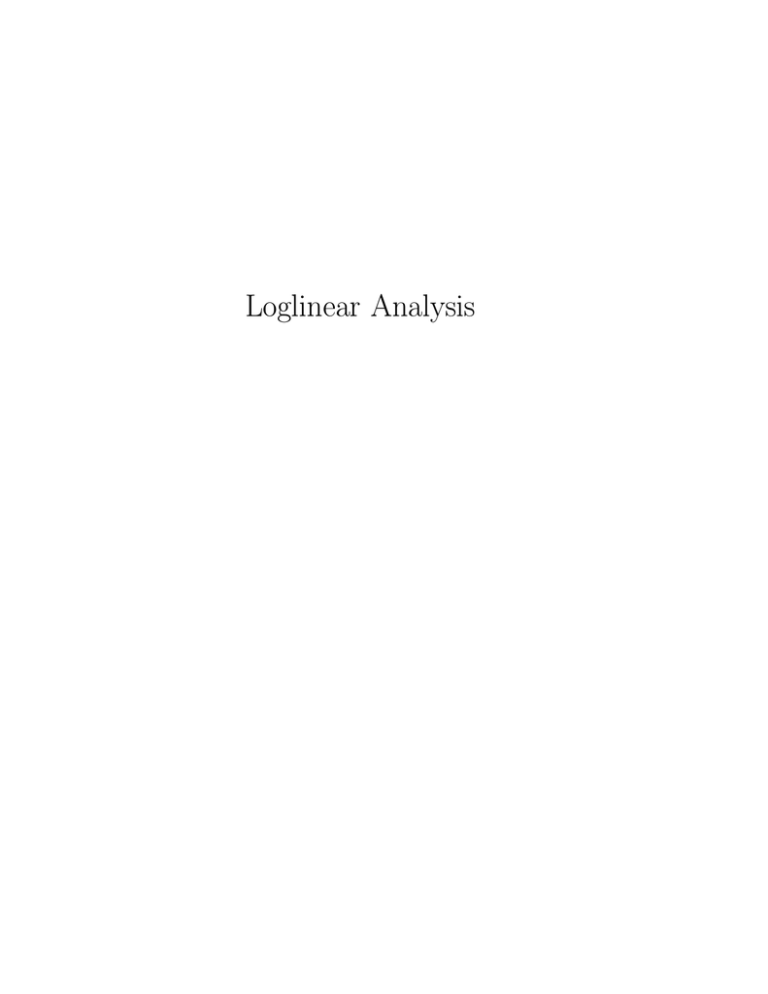
Loglinear Analysis
Information in this document is subject to change without notice and does not
represent a commitment on the part of Aptech Systems, Inc. The software described in
this document is furnished under a license agreement or nondisclosure agreement. The
software may be used or copied only in accordance with the terms of the agreement.
The purchaser may make one copy of the software for backup purposes. No part of this
manual may be reproduced or transmitted in any form or by any means, electronic or
mechanical, including photocopying and recording, for any purpose other than the
purchaser’s personal use without the written permission of Aptech Systems, Inc.
c
Copyright
1988-1996 by Aptech Systems, Inc., Maple Valley, WA.
All Rights Reserved.
GAUSS, GAUSS Engine, GAUSSi, GAUSS Light, GAUSS-386 and GAUSS-386i are
trademarks of Aptech Systems, Inc. All other trademarks are the properties of their
respective owners.
Documentation Version: January 15, 2001
Contents
1 Installation
1
1.1 UNIX . . . . . . . . . . . . . . . . . . . . . . . . . . . . . . . . . . . . . .
1.1.1
1
Solaris 2.x Volume Management . . . . . . . . . . . . . . . . . . .
2
1.2 DOS . . . . . . . . . . . . . . . . . . . . . . . . . . . . . . . . . . . . . . .
2
1.3 Differences Between the UNIX and DOS Versions . . . . . . . . . . . . . .
3
2 Loglinear Analysis
2.1 Getting Started . . . . . . . . . . . . . . . . . . . . . . . . . . . . . . . . .
5
5
2.1.1
README Files . . . . . . . . . . . . . . . . . . . . . . . . . . . . .
5
2.1.2
Setup . . . . . . . . . . . . . . . . . . . . . . . . . . . . . . . . . .
5
2.2 The Loglinear Model . . . . . . . . . . . . . . . . . . . . . . . . . . . . . .
6
2.3 General Design . . . . . . . . . . . . . . . . . . . . . . . . . . . . . . . . .
8
2.4 Global Control Variables . . . . . . . . . . . . . . . . . . . . . . . . . . . .
12
2.5 References . . . . . . . . . . . . . . . . . . . . . . . . . . . . . . . . . . . .
13
3 Loglinear Analysis Reference
15
letters . . . . . . . . . . . . . . . . . . . . . . . . . . . . . . . . . . . . . . . . .
16
ll3way . . . . . . . . . . . . . . . . . . . . . . . . . . . . . . . . . . . . . . . . .
18
lldesign . . . . . . . . . . . . . . . . . . . . . . . . . . . . . . . . . . . . . . . .
20
llest . . . . . . . . . . . . . . . . . . . . . . . . . . . . . . . . . . . . . . . . . .
21
llhier . . . . . . . . . . . . . . . . . . . . . . . . . . . . . . . . . . . . . . . . . .
23
llout . . . . . . . . . . . . . . . . . . . . . . . . . . . . . . . . . . . . . . . . . .
26
llset . . . . . . . . . . . . . . . . . . . . . . . . . . . . . . . . . . . . . . . . . .
28
lltable . . . . . . . . . . . . . . . . . . . . . . . . . . . . . . . . . . . . . . . . .
29
lluser . . . . . . . . . . . . . . . . . . . . . . . . . . . . . . . . . . . . . . . . . .
30
Index
ii
33
Installation
Chapter 1
Installation
1.1 UNIX
If you are unfamiliar with UNIX, see your system administrator or system
documentation for information on the system commands referred to below. The device
names given are probably correct for your system.
1. Use cd to make the directory containing GAUSS the current working
directory.
2. Use tar to extract the files.
tar xvf device name
If this software came on diskettes, repeat the tar command for each
diskette.
The following device names are suggestions. See your system administrator. If you are
using Solaris 2.x, see Section 1.1.1.
Operating System
Solaris 1.x SPARC
Solaris 2.x SPARC
Solaris 2.x SPARC
Solaris 2.x x86
Solaris 2.x x86
HP-UX
IBM AIX
SGI IRIX
3.5-inch diskette
/dev/rfd0
/dev/rfd0a (vol. mgt. off)
/vol/dev/aliases/floppy0
/dev/rfd0c (vol. mgt. off)
/vol/dev/aliases/floppy0
/dev/rfloppy/c20Ad1s0
/dev/rfd0
/dev/rdsk/fds0d2.3.5hi
1/4-inch tape
/dev/rst8
/dev/rst12
/dev/rst12
DAT tape
/dev/rmt/1l
/dev/rmt/1l
/dev/rmt/1l
/dev/rmt/1l
/dev/rmt/0m
/dev/rmt.0
1
1. INSTALLATION
1.1.1 Solaris 2.x Volume Management
If Solaris 2.x volume management is running, insert the floppy disk and type
volcheck
to signal the system to mount the floppy.
The floppy device names for Solaris 2.x change when the volume manager is turned off
and on. To turn off volume management, become the superuser and type
/etc/init.d/volmgt off
To turn on volume management, become the superuser and type
/etc/init.d/volmgt on
1.2 DOS
1. Place the diskette in a floppy drive.
2. Log onto the root directory of the diskette drive. For example:
A:<enter>
cd\<enter>
3. Type: ginstall source drive target path
source drive
Drive containing files to install
with colon included
For example: A:
target path
Main drive and subdirectory to install
to without a final \
For example: C:\GAUSS
A directory structure will be created if it does not already exist and the files
will be copied over.
target path\src
source code files
target path\lib
library files
target path\examples
example files
2
1. INSTALLATION
1.3 Differences Between the UNIX and DOS Versions
• In the DOS version, when the global
output = 2, information may be written
to the screen using commands requiring the ANSI.SYS screen driver. These are
not available in the current UNIX version, and therefore setting
output = 2
may have the same effect as setting
output = 1.
• If the functions can be controlled during execution by entering keystrokes from
the keyboard, it may be necessary to press Enter after the keystroke in the
UNIX version.
• On the Intel math coprocessors used by the DOS machines, intermediate
calculations have 80-bit precision, while on the current UNIX machines, all
calculations are in 64-bit precision. For this reason, GAUSS programs executed
under UNIX may produce slightly different results, due to differences in
roundoff, from those executed under DOS.
3
Installation
4. The screen output option used may require that the DOS screen driver
ANSI.SYS be installed on your system. If ANSI.SYS is not already installed
on your system, you can put the command like this one in your
CONFIG.SYS file:
DEVICE=C:\DOS\ANSI.SYS
(This particular statement assumes that the file ANSI.SYS is on the
subdirectory DOS; modify as necessary to indicate the location of your copy
of ANSI.SYS.)
1. INSTALLATION
4
Chapter 2
The LOGLINEAR ANALYSIS module contains a set of routines for the analysis of
categorical data using loglinear analysis. These routines can estimate most of the
models considered in such texts as Y.M.M. Bishop, S.E. Fienberg and P.W. Holland
(1975) Discrete Multivariate Analysis, A. Agresti (1984) Analysis of Ordinal Categorical
Data, and S. Haberman (1979) Analysis of Qualitative Data, Volumes 1 and 2.
Estimation is performed in this module with the procedure llest which computes
maximum likelihood estimates by the Newton-Raphson method. The other routines are
for entering data, constructing design matrices, easily passing information to llest, and
printing the results. Input tables can be entered with the GAUSS editor, from the
keyboard using the program lltable, or with a table constructed from raw data using
the GAUSS procedure crosstab.
2.1 Getting Started
GAUSS 3.1.0+ is required to use these routines.
2.1.1 README Files
The file README.ll contains any last minute information on this module. Please read it
before using the procedures in this module.
2.1.2 Setup
In order to use the procedures in the LOGLINEAR ANALYSIS module, the module
library must be active. This is done by including loglin in the LIBRARY statement at
5
Loglinear Analysis
Loglinear Analysis
2. LOGLINEAR ANALYSIS
the top of your program:
library loglin,quantal,pgraph;
This enables GAUSS to find the LOGLINEAR ANALYSIS procedures. If you plan to
make any right-hand references to the global variables (described in section 2.4), you
will also need the statement:
#include loglin.ext;
Finally, to reset global variables in succeeding executions of the program the following
instruction can be used:
llset;
This could be included with the above statements without harm and would insure the
proper definition of the global variables for all executions of the program.
The version number of each module is stored in a global variable. For LOGLINEAR
ANALYSIS , this global variable is:
ll ver
3×1 matrix, the first element contains the major version number, the
second element the minor version number, and the third element the
revision number.
If you call for technical support, you may be asked for the version of your copy of this
module.
2.2 The Loglinear Model
This section presents the basic ideas related to the loglinear model. This is done
primarily to clarify the notation that will be used below. The reader who is not familiar
with these models should consult one of the texts given in the references.
Consider a K-way table constructed from variables V i (i = 1, K), with variable Vi having
Ki categories. The resulting table contains N = K 1 ∗ K2 ∗ . . . KK cells. The observed
variables for this table are contained in the N x1 vector n. Let the N cell indices
associated with n be contained in the KxN matrix T where element t ij is the category
level of variable Vj for ni . For example, for a 2x2x2 table (K = 3):
A=1
B=1
B=2
6
C=1
1
3
A=2
C=2
2
4
B=1
B=2
C=1
5
7
C=2
6
8
2. LOGLINEAR ANALYSIS
n and T would be:
1
1
1
1
T =
2
2
2
2
1
1
2
2
1
1
2
2
1
2
1
2
1
2
1
2
Loglinear Analysis
1
2
3
4
n=
5
6
7
8
Let m be a Nx1 vector of expected cell frequencies for the loglinear model. The
loglinear model is defined as:
log m = Dβ
for a NxP design matrix D with P parameters in the Px1 vector β.
Estimation is based on the assumption that the n i are independent Poisson random
variables with expected values equal to mi . β is estimated by the Newton-Raphson
method, based on an algorithm presented in Agresti (1984).
The loglinear model is overparameterized, which means that constraints must be
imposed on the parameters. Different programs use different constraints. Most
commonly, parameters are constrained to sum to zero over the level of an individual
variable. Alternatively, the parameter associated with the first level of any variable can
be fixed to zero. llest allows either set of constraints.
The specific loglinear model is defined by its design matrix. The LOGLINEAR
ANALYSIS module contains a number of procedures for automatically constructing
common kinds of design matrices. Alternatively, the user can construct his or her own
design matrix to pass to llest.
An important class of models is called hierarchical models. These models are uniquely
specified by the configurations that are fit by the model. A configuration is defined as a
table formed from the original table by collapsing over dimensions of the table. For
example, V1 V3 would be the table formed from V1 V2 . . . VK by collapsing over V2 , V4 ,
. . ., VK . For purposes of describing hierarchical models in the procedures described
below, variables will be referred to by number (e.g., 1, 2) and configurations will be
defined by integers containing the variables in the table (e.g., the configuration for
variables 1 and 3 is indicated as 13).
Tables with cell weights can also be analyzed. Thus, the model being estimated is
somewhat more general than indicated above. Specifically, the model with weights is:
log(mi /zi ) = βk Xik
7
2. LOGLINEAR ANALYSIS
where zi is the cell weight associated with cell i. See Haberman (1979) for details on
this form of the model. Clogg and Eliason (1988) provide a number of examples of
using cell weights.
In its simplest form, weighting allows the analysis of incomplete tables. Incomplete
tables are tables in which some of the cells are to be excluded from analysis. These cells
are considered to have structural zeros. To indicate which cells have structural zeros,
an Nx1 vector Z is constructed with a 1 for cells to be analyzed and a 0 for cells to be
dropped from analysis. The example files llquasi.e and llrate.e provide examples
of weighting.
2.3 General Design
The LOGLINEAR ANALYSIS module consists of a set of main procedures, auxiliary
procedures called by the main procedures, and global variables controlling aspects of
estimation and output. The main procedures are:
letters
ll3way
lldesign
llest
llhier
llout
lltable
lluser
Set global variable llettrs to a character vector of labels.
Estimate all 3-way hierarchical models for a table.
Input a design matrix for use with llest.
Compute maximum likelihood estimates for a loglinear model.
Estimate a hierarchical model given its fit configurations.
Print the estimates for a loglinear model.
Input a table for use with llest.
Estimate a model with a user-supplied design.
llest is the central routine that estimates a loglinear model given a specific table, a set
of weights, and a design matrix. llest will make efforts to fix an improper design
matrix. For example, columns with all zeros are deleted, and a warning is printed.
Further, if singularities are encountered that cannot be eliminated, the offending design
matrix is printed along with an explanation. The degrees of freedom for the model are
computed with methods suggested by Clogg and Eliason (1988). Essentially, the rank
of the design matrix is subtracted from the number of cells without either structural or
fitted zeros.
To see how llest is used, consider the hierarchical model 12,3 for the 2x2x2 table 123.
Assume that all cells are to be analyzed. The loglinear model could be estimated as:
n = { 32, 86, 11, 35, 6, 73, 41, 70 };
d = { 1
1
1
1
1
1,
1
1
1 -1
1 -1,
1
1 -1
1 -1
1,
8
2. LOGLINEAR ANALYSIS
1
1
1
1
1
1
-1
-1
-1
-1
-1
1
1
-1
-1
-1
1
-1
1
-1
-1
-1
-1
1
1
-1,
-1,
1,
-1,
1 };
{ m,b,v,gsq,df,tol } = llest(n,0,d);
t = { 1 1 1,
1 1 2,
1 2 1,
1 2 2,
2 1 1,
2 1 2,
2 2 1,
2 2 2 };
llout(t,m,b,vc,gsq,df,tol,n,0,d,0,0,0);
In general, it is tedious and error-prone to enter design matrices and tables. The
procedure lltable prompts the user for the number of variables, the number of
categories per variable, and the value for each cell. The user is given the option of
specifying cell weights. The user can provide a name of up to seven letters (e.g.,
“myname”) which the program will use to place the table indices, cell counts and
weights in global matrices (here, mynamet, mynamen and mynamez). If desired, these
matrices will be saved to disk.
The procedure lldesign prompts the user for the number of rows and columns in the
design matrix and prompts for each element of the design matrix. The rows correspond
to cells in the table and the columns correspond to parameters. The user can provide a
name of up to seven letters (e.g., “myname”) which the program will use to place the
design matrix in a global matrix (here, mynamed). If desired, the matrix will be saved
to disk.
If the design matrix, table, and cell indices have been entered, the procedure lluser can
be used to pass the table indices, cell counts and user-defined design matrix to llest and
print the results with llout. For example:
library loglin;
llset;
loadm myn, myt, myd;
call lluser(myt,myn,0,myd,0,0);
9
Loglinear Analysis
llest returns various useful pieces of information that are discussed below. However, the
procedure llout translates this information into a convenient form. Thus, readable
results could be obtained by adding the matrix of cell indices and calling llout:
2. LOGLINEAR ANALYSIS
Having complete control over the design matrix is useful for many specialized models.
Consider the row effects model presented on page 87 of Agresti (1985). Assume that
the cell counts and table indices are saved in agr87t and agr87n. Then the row effects
model could be estimated as:
/* 1 */
/* 2 */
/* 3 */
/*
/*
/*
/*
4
5
6
7
*/
*/
*/
*/
/* 8 */
/* 9 */
/* lluser.e: Agresti, page 87 */
library loglin;
llset;
loadm agr87t,agr87n;
agr87d =
{ 1 1 0 1 0 -1 0,
1 1 0 0 1 0 0,
1 1 0 -1 -1 1 0,
1 0 1 1 0 0 -1,
1 0 1 0 1 0 0,
1 0 1 -1 -1 0 1,
1 -1 -1 1 0 1 1,
1 -1 -1 0 1 0 0,
1 -1 -1 -1 -1 -1 -1 };
save agr87d;
cls;
output file = "lluser1.out" reset;
print "lluser.e: Row Effects Model from Agresti, page 87.";
print;
call lluser(agr87t,agr87n,0,agr87d,0,0);
output off;
The numbers to the left are for reference purposes only.
Line (1) labels the program.
Line (2) loads the cell frequencies and indices.
Line (3) inputs the design matrix.
Line (4) saves the design matrix for later use.
Line (5) clears the screen.
Line (6) creates the output file.
Line (7) labels the output.
Line (8) calls llest and llout and thus estimates the model.
Line (9) turns off the output.
This program is saved as lluser.e in the examples subdirectory.
While manually entering the design matrix provides a great deal of flexibility, it is
tedious and error-prone. For hierarchical models, there are two procedures that do
most of the work:
10
2. LOGLINEAR ANALYSIS
ll3way
computes all possible hierarchical models for a three-way table. All the
user must provide is the cell indices and the table. For example,
assuming that t and n are in memory:
ll3way(t,n,z);
would estimate all models for the table with indices t, counts n, and
weights contained in z .
estimates the hierarchical model described by the configurations that are
to be fit. For example,
/* llhier1.e: Fienberg, page 27. */
library loglin;
llset;
loadm fien27t,fien27n;
print;
output file = "llhier1.out" reset;
print "llhier1.e: Fienberg, page 27.";
print;
print "Model 1: Conditional independence.";
print;
cfg = { 13, 12 };
nm = { Fien3, Fien2, Fien1 };
call llhier(fien27t,fien27n,0,cfg,nm);
print;
print "Model 2: Complete independence.";
print;
cfg = { 1, 2, 3 };
call llhier(fien27t,fien27n,0,cfg,nm);
output off;
would estimate two hierarchical models for the table stored in fien27t
and fien27n. This program is saved as llhier1.e in the examples
subdirectory.
letters
Sets global variable
llettrs to a character vector of labels. For example:
letters("S X U V W")
would set llettrs to a vector with S, X, U, V and W in it. With letters
it is possible to specify models with letters rather than numbers. For
example: SU, VW rather than 13, 45.
The procedures ll3way, llhier and lluser illustrate the ways in which llest and llout can
be used to construct customized applications for loglinear modeling.
llhier
constructs a design matrix for hierarchical models, passes it to llest for
estimation, and passes the results to llout for printing.
11
Loglinear Analysis
llhier
2. LOGLINEAR ANALYSIS
ll3way
loops through all hierarchical models for three-way tables, passes the
design matrix to llest, and prints the goodness of fit of each model.
lluser
is a very simple procedure that takes information on a table and design
matrix and passes them to llest, and then passes the results to llout.
Taking these three procedures as models, one could easily create a specialized
procedure for logit type models, models for ordered data, and so on.
2.4 Global Control Variables
The following global variables are used in LOGLINEAR ANALYSIS to control various
options. Chapter 3 provides details on which globals affect which procedures. The
defaults can be changed by modifying the DECLARE statements in loglinear.dec .
Alternatively, the defaults can be changed by setting new values immediately before
using the LOGLINEAR ANALYSIS procedures.
llmaxit
scalar, indicates the maximum number of iterations. If convergence is not
reached within 25 iterations, it generally means that there is a problem
with the model. When llmaxit is exceeded, a warning is printed along
with the results. These results are to help you assess the problem; they
are NOT correct. Default = 25.
llettrs
Kx1 character vector, contains the characters that will be used as
mnemonics for labeling the output. The first element is associated with
the first variable, the second with the second, etc. The abbreviations
supplied in llettrs are used to label the output in llout. By default, A,
B, ... are used as abbreviations for variables.
llmult
scalar. Values are:
0
print coefficients for the loglinear model.
1
print coefficients for the multiplicative model. The parameters in the
multiplicative models are simply the exponential of the parameters
in the loglinear model.
Default = 0.
llprtd
scalar. If 1, print the design matrix. Default = 1.
llprtit
scalar. If 1, print the information on iterations. Default = 1.
llprtt
scalar. If 1, print the table of cell counts, expected values, residuals and
weights. Default = 1.
12
2. LOGLINEAR ANALYSIS
llprte
scalar. If 0, the estimates of the parameters are not printed. This is useful
if you just want the chi-squares or expected cell frequencies. Default = 1.
llsum0
scalar. Values are (default = 1):
0
parameters for first level of any variable are constrained to zero.
1
parameters in the hierarchical model are constrained to sum to 0
across the level of any variable.
scalar. Sets tolerance for convergence. Tolerance is defined as the
maximum difference between the coefficients of the current iteration and
the previous one. Default = 1e−5.
lltwo
scalar. Values are (default = 0):
0
do not double or square the coefficients. This is useful if logit models
are being estimated.
1
print two times the additive coefficients or the squared multiplicative
coefficients.
2.5 References
Agresti, A. 1984. Analysis of Ordinal Categorical Data. New York:Wiley.
Bishop, Y.M.M, S.E. Fienberg and P.W. Holland (1975) Discrete Multivariate Analysis.
Boston:MIT Press.
Clogg, C.C. and S.R. Eliason. 1988. “Some common problems in log-linear analysis.”
Pp. 226-257 in Long, Common Problems/Proper Solutions. Beverly
Hills:Sage University Press.
Fienberg, S.E. 1980. The Analysis of Cross-Classified Categorical Data. Boston:MIT
Press.
13
Loglinear Analysis
lltol
2. LOGLINEAR ANALYSIS
14
Chapter 3
Loglinear Analysis Reference
Reference
15
letters
3. LOGLINEAR ANALYSIS REFERENCE
Library
loglin
Purpose
Sets global variable
llettrs to a character vector of labels.
Format
letters(str);
Input
str
string, containing a list of one character variables.
Output
None.
Global Output
llettrs
Kx1 character vector, contains the characters that will be used as
mnemonics for labeling the output. The first element is associated with
the first variable, the second with the second, etc. The abbreviations
supplied in llettrs are used to label the output in llout. By default, A,
B, ... are used as abbreviations for variables.
Remarks
For example:
letters("S X U V W")
would set llettrs to a vector with S, X, U, V and W in it. With letters it is possible
to specify models with letters rather than numbers. For example: SU, VW rather than
13, 45.
16
letters
3. LOGLINEAR ANALYSIS REFERENCE
Example
library loglin;
#include loglin.ext;
llset;
loadm fien27t,fien27n;
letters("S D H");
cfg = { SH, SD };
nm = { SPECIES, DIAMETER, HEIGHT };
call llhier(fien27t,fien27n,0,cfg,nm);
Source
llappl.src
See also
llhier
Reference
17
ll3way
3. LOGLINEAR ANALYSIS REFERENCE
Library
loglin
Purpose
Estimates all hierarchical models for a three-way table.
Format
ll3way(t,n,z );
Input
t
NxP matrix of cell indices, where N equals ROWS(n) and P equals the
rows of the coefficient matrix.
n
Nx1 matrix of cell counts of table.
z
Nx1 matrix with cell weights.
Output
None.
Globals
llmaxit
scalar, indicates the maximum number of iterations. If convergence is not
reached within 25 iterations, it generally means that there is a problem
with the model. When llmaxit is exceeded, a warning is printed along
with the results. These results are to help you assess the problem; they
are NOT correct. Default = 25.
llprtit
scalar. If 1, print information on iterations. For this procedure, it is best
to set llprtit to 0. Default = 1.
lltol
scalar. Sets tolerance for convergence. Tolerance is defined as the
maximum difference between the coefficients of the current iteration and
the previous one. Default = 1e−5.
output
scalar. If nonzero, intermediate results are printed. Under UNIX, default
= 1; under DOS, default = 2.
Remarks
Likelihood ratio and Pearson chi-squares for all seventeen possible loglinear models for
three-way tables are printed.
The procedures llhdsgn, lldigit and
documented in the file llappl.src.
18
llsubcn are called by this procedure. These are
ll3way
3. LOGLINEAR ANALYSIS REFERENCE
Example
library loglin;
llset;
loadm fien27t,fien27n;
_llprtit = 0;
print "ll3way.e: See Fienberg, page 42.";
ll3way(fien27t,fien27n,0);
Source
llappl.src
See also
llest, lltable, lldesign, llout, llhier, lluser
Reference
19
lldesign
3. LOGLINEAR ANALYSIS REFERENCE
Library
loglin
Purpose
Interactively input a design matrix for analysis with llest.
Format
lldesign;
Input
The user is prompted for the number of rows and columns in the design matrix. The
rows correspond to the cells of the table, the columns to the parameters to be
estimated. The user is then prompted to enter elements of the design matrix. Finally, a
name of up to seven characters may be given to name the matrix.
Output
None.
Remarks
Assume that name is the user-supplied name to specify the matrices. lldesign then
creates the global design matrix named.
The user is given the option to save the outputs to disk.
Example
library loglin;
llset;
lltable;
/* respond to prompts from lltable to create myt, myz and myn */
lldesign;
/* respond to prompts from lldesign to create myd */
call lluser(myt,myn,myz,myd,0,0);
Source
llinput.src
See also
llest, lltable, llout, llhier, ll3way, lluser
20
llest
3. LOGLINEAR ANALYSIS REFERENCE
Library
loglin
Purpose
Estimates a loglinear model by maximum likelihood.
Format
{ m,b,vc,gsq,df ,tol } = llest(n,z ,d);
Input
n
Nx1 matrix of cell counts of table, where N is the number of cells.
z
Nx1 matrix with cell weights.
d
NxP design matrix, where P is the number of parameters to be
estimated. The rows of d correspond to the cells in n.
Reference
Output
m
Nx1 vector of expected cell frequencies, in the same order as n.
b
Px1 vector of parameter estimates.
vc
PxP covariance matrix of b.
gsq
scalar, likelihood ratio chi-square.
df
scalar, degrees of freedom associated with the model. The degrees of
freedom are computed as the difference between the number of nonzero
fitted cells and the rank of the design matrix.
tol
scalar, the actual tolerance at convergence.
Globals
llmaxit
scalar, indicates the maximum number of iterations. If convergence is not
reached within 25 iterations, it generally means that there is a problem
with the model. When llmaxit is exceeded, a warning is printed along
with the results. These results are to help you assess the problem; they
are NOT correct. Default = 25.
llprtit
scalar. If 1, print information on iterations. Default = 1.
21
llest
3. LOGLINEAR ANALYSIS REFERENCE
lltol
scalar. Sets tolerance for convergence. Tolerance is defined as the
maximum difference between the coefficients of the current iteration and
the previous one. Default = 1e−5.
Remarks
Maximum likelihood estimation is performed by the Newton-Raphson method. The
program is based on a SAS program written by Agresti (1984).
Source
llest.src
See also
lltable, lldesign, llout, llhier, ll3way, lluser
22
llhier
3. LOGLINEAR ANALYSIS REFERENCE
Library
loglin
Purpose
Estimates a loglinear hierarchical model defined by a set of configurations to be fit.
Format
{ m,b,covb,gsq,df ,tol,dsgn } = llhier(t,n,z ,cfg,nm);
Input
NxP matrix of cell indices.
n
Nx1 matrix of cell counts of table.
z
Nx1 matrix of cell weights.
cfg
Px1 character vector of character labels
– or –
Px1 numeric vector of variable indices
Reference
t
of the configurations to be fit.
nm
Qx1 character vector of variable names, or 0 for no names.
Output
m
Nx1 vector of expected cell frequencies, in the same order as n.
b
Px1 vector of parameter estimates.
covb
PxP covariance matrix of b.
gsq
scalar, likelihood ratio chi-square.
df
scalar, degrees of freedom associated with the model. The degrees of
freedom are computed as the difference between the number of nonzero
fitted cells and the rank of the design matrix.
tol
scalar, the actual tolerance at convergence.
dsgn
scalar, the design matrix that was estimated.
23
llhier
3. LOGLINEAR ANALYSIS REFERENCE
Globals
llmaxit
scalar, indicates the maximum number of iterations. If convergence is not
reached within 25 iterations, it generally means that there is a problem
with the model. When llmaxit is exceeded, a warning is printed along
with the results. These results are to help you assess the problem; they
are NOT correct. Default = 25.
llettrs
Kx1 character vector, contains the characters that will be used as
mnemonics for labeling the output. The first element is associated with
the first variable, the second with the second, etc. The abbreviations
supplied in llettrs are used to label the output in llout. By default, A,
B, ... are used as abbreviations for variables.
llmult
scalar. Values are:
0
print coefficients for the loglinear model.
1
print coefficients for the multiplicative model. The parameters in the
multiplicative models are simply the exponential of the parameters
in the loglinear model.
Default = 0.
llprtd
scalar. If 1, print the design matrix. Default = 1.
llprte
scalar. If 0, the estimates of the parameters are not printed. Default = 1.
llprtit
scalar. If 1, print the information on iterations. Default = 1.
llprtt
scalar. If 1, print the table of cell counts, expected values, residuals and
weights. Default = 1.
llsum0
scalar. Values are (default = 1):
0
parameters for first level of any variable are constrained to zero.
1
parameters in the hierarchical model are constrained to sum to 0
across the level of any variable.
lltol
scalar. Sets tolerance for convergence. Tolerance is defined as the
maximum difference between the coefficients of the current iteration and
the previous one. Default = 1e−5.
lltwo
scalar. Values are (default = 0):
24
1
print two times the additive coefficients or the squared multiplicative
coefficients.
0
do not double or square the coefficients. This is useful if logit models
are being estimated.
llhier
3. LOGLINEAR ANALYSIS REFERENCE
output
scalar. If nonzero, intermediate results are printed. Under UNIX, default
= 1; under DOS, default = 2.
Remarks
Results of the estimation are also sent to the output device.
The procedures llhdsgn, lldigit, and llsubcn are called by this procedure. These
are documented in the file llappl.src .
Example
library loglin;
llset;
cfg = { 13, 12 };
nm = { VAR_A, VAR_B, VAR_C };
call llhier(t,n,0,cfg,nm);
Source
Reference
llappl.src
See also
lltable, lldesign, llout, llhier, ll3way, lluser
25
llout
3. LOGLINEAR ANALYSIS REFERENCE
Library
loglin
Purpose
Prints the results obtained from llest.
Format
llout(t,m,b,vc,gsq,df ,tol,n,z ,d,xcfg,nm,lbl);
Input
t
NxP matrix of cell indices.
m
Nx1 vector of expected cell counts.
b
Px1 vector of parameter estimates.
vc
PxP covariance matrix of estimates in b.
gsq
scalar, likelihood ratio chi-square.
df
scalar, degrees of freedom associated with the model. The degrees of
freedom are computed as the difference between the number of nonzero
fitted cells and the rank of the design matrix.
tol
scalar, the actual tolerance at convergence. If this is not less than
the estimates did not converge.
n
Nx1 vector of cell counts of table.
z
Nx1 vector of cell weights.
d
NxP design matrix, where P is the number of parameters to be
estimated. The rows of d correspond to the cells in n.
xcfg
scalar, configurations fit in hierarchical model. If the model is not
hierarchical or you do not want the configurations printed, set xcfg = 0.
nm
Nx1 character vector of variable names, or 0 for no names.
lbl
Px1 character vector of labels to be associated with parameters being
estimated. If 0, parameters will not be labeled.
Output
Results are sent to the output device.
26
lltol,
llout
3. LOGLINEAR ANALYSIS REFERENCE
Globals
llmult
scalar. Values are:
0
print coefficients for the loglinear model.
1
print coefficients for the multiplicative model. The parameters in the
multiplicative models are simply the exponential of the parameters
in the loglinear model.
Default = 0.
llprtd
scalar. If 1, print the design matrix. Default = 1.
llprtt
scalar. If 1, print the table of cell counts, expected values, residuals and
weights. Default = 1.
lltwo
scalar. Values are (default = 0):
1
0
scalar. If nonzero, intermediate results are printed. Under UNIX, default
= 1; under DOS, default = 2.
Remarks
This routine may be used to output the results from any use of llest.
Example
This example illustrates how llest and llout can be combined to create routines to
simplify the estimation of loglinear models. This procedure is documented as lluser.
proc (0) = lluser(t,n,z,d,nm,lbl);
local m,b,vc,gsq,df,tol,xcfg;
xcfg = 0;
{ m,b,vc,gsq,df,tol } = llest(n,z,d);
llout(t,m,b,vc,gsq,df,tol,n,z,d,xcfg,nm,lbl);
endp; /* lluser */
Source
llest.src
See also
llest, lltable, lldesign, llhier, ll3way, lluser
27
Reference
output
print two times the additive coefficients or the squared multiplicative
coefficients.
do not double or square the coefficients. This is useful if logit models
are being estimated.
llset
3. LOGLINEAR ANALYSIS REFERENCE
Library
loglin
Purpose
Resets global variables.
Format
llset;
Input
None.
Output
None.
Remarks
Putting this instruction at the top of all programs that invoke LOGLINEAR
ANALYSIS procedures is generally good practice. This will prevent globals from being
inappropriately defined when a program is run either several times or after another
program that also calls LOGLINEAR ANALYSIS procedures.
llset calls gausset.
Source
llappl.src
28
lltable
3. LOGLINEAR ANALYSIS REFERENCE
Library
loglin
Purpose
Interactively constructs a table for analysis by llest.
Format
lltable;
Input
The user is prompted for the number of variables and the number of categories per
variable. The user is then prompted to enter cell counts. Optionally, the user may
specify cell weights. Finally, a name of up to seven characters may be given to name
the matrices.
Assume that name is the user-supplied name to specify the matrices. lltable creates the
following global matrices:
namen
Nx1 matrix of cell counts of table, where N is the number of cells.
namez
Nx1 matrix of cell weights.
namet
NxP matrix of cell indices associated with namen.
Globals
None.
Remarks
The user is given the option to save the outputs to disk.
Source
llinput.src
See also
llest, lldesign, llout, llhier, ll3way, lluser
29
Reference
Output
lluser
3. LOGLINEAR ANALYSIS REFERENCE
Library
loglin
Purpose
Estimates and prints results for a loglinear model based on a user-supplied design
matrix.
Format
{ m,b,covb,gsq,df ,tol } = lluser(t,n,z ,d,nm,lbl);
Input
t
NxP matrix of cell indices.
n
Nx1 matrix of cell counts of table.
z
Nx1 matrix of cell weights.
d
NxP design matrix, where P is the number of parameters to be
estimated. The rows of d correspond to the cells in n.
nm
Nx1 vector of variable names, or 0 for no names.
lbl
Px1 vector of parameter names. If 0, parameters will not be given names.
Output
m
Nx1 vector of expected cell frequencies, in same order as n.
b
Px1 vector of parameter estimates.
covb
PxP covariance matrix of b.
gsq
scalar, likelihood ratio chi-square.
df
scalar, degrees of freedom associated with the model. The degrees of
freedom are computed as the difference between the number of nonzero
fitted cells and the rank of the design matrix.
tol
scalar, the actual tolerance at convergence.
Globals
30
lluser
3. LOGLINEAR ANALYSIS REFERENCE
llmaxit
scalar, indicates the maximum number of iterations. If convergence is not
reached within 25 iterations, it generally means that there is a problem
with the model. When llmaxit is exceeded, a warning is printed along
with the results. These results are to help you assess the problem; they
are NOT correct. Default = 25.
llmult
scalar. Values are:
0
print coefficients for the loglinear model.
1
print coefficients for the multiplicative model. The parameters in the
multiplicative models are simply the exponential of the parameters
in the loglinear model.
Default = 0.
scalar. If 1, print the design matrix. Default = 1.
llprtit
scalar. If 1, print the information on iterations. Default = 1.
llprtt
scalar. If 1, print the table of cell counts, expected values, residuals and
weights. Default = 1.
lltol
scalar. Sets tolerance for convergence. Tolerance is defined as the
maximum difference between the coefficients of the current iteration and
the previous one. Default = 1e−5.
lltwo
scalar. Values are (default = 0):
output
1
print two times the additive coefficients or the squared multiplicative
coefficients.
0
do not double or square the coefficients. This is useful if logit models
are being estimated.
scalar. If nonzero, intermediate results are printed. Under UNIX, default
= 1; under DOS, default = 2.
Remarks
Results of the estimation are also sent to the output device.
Example
This example will estimate the row effect model for ordinal data.
31
Reference
llprtd
lluser
3. LOGLINEAR ANALYSIS REFERENCE
library loglin;
llset;
loadm agr87t,agr87n;
agr87d =
{ 1 1 0 1 0 -1 0,
1 1 0 0 1 0 0,
1 1 0 -1 -1 1 0,
1 0 1 1 0 0 -1,
1 0 1 0 1 0 0,
1 0 1 -1 -1 0 1,
1 -1 -1 1 0 1 1,
1 -1 -1 0 1 0 0,
1 -1 -1 -1 -1 -1 -1 };
output file = ll1.out reset;
call lluser(agr87t,agr87n,0,agr87d,0,0);
output off;
Source
llappl.src
See also
lltable, lldesign, llout, llhier, ll3way
32
Index
cell frequencies, 10
cell weights, 7, 9, 29
constraints, 7
convergence, 12, 18, 21, 24
convergence, tolerance at, 21, 23, 26, 30
covariance matrix, 30
D
degrees of freedom, 8, 21, 23, 26, 30
design matrix, 7, 20, 23, 30
design matrix, improper, 8
DOS, 2, 3
E
expected cell frequencies, 7, 30
F
fitted zeros, 8
G
H
hierarchical models, 7, 8, 10, 18, 23, 26
I
Installation, 1
iterations, maximum number of, 12, 18,
21, 24, 31
M
L
maximum likelihood estimation, 21, 22
letters, 8, 11, 16
N
Index
global variables, 12
likelihood ratio, 18
likelihood ratio chi-square, 26, 30
ll3way, 8, 11, 18
llappl.src, 18, 25
lldesign, 8, 9, 20
lldigit, 18, 25
llest, 5, 7, 8, 9, 20, 21, 26, 27
llettrs, 12, 16, 24
llhdsgn, 18, 25
llhier, 8, 11, 23
llinput.src, 20
llmaxit, 12, 18, 21, 24, 31
llmult, 12, 24, 27, 31
llout, 8, 9, 26
llprtd, 12, 24, 27, 31
llprte, 13, 24
llprtit, 12, 18, 21, 24, 31
llprtt, 12, 24, 27, 31
llquasi.e, 8
llrate.e, 8
llset, 28
llsubcn, 18, 25
llsum0, 13, 24
lltable, 5, 8, 9, 29
lltol, 13, 18, 22, 24, 31
lltwo, 13, 24, 27, 31
lluser, 8, 9, 27, 30
logit type models, 12
loglinear model, 7
loglinear.dec, 12
INDEX
Newton-Raphson method, 5, 7, 22
O
ordinal data, 31
output, 18, 25, 27, 31
P
parameter estimates, 30
Pearson chi-squares, 18
R
random variables, Poisson, 7
S
SAS, 22
singularities, 8
structural zeros, 8
T
tables, incomplete, 8
U
UNIX, 1, 3
W
weighting, 8
weights, 8
34


